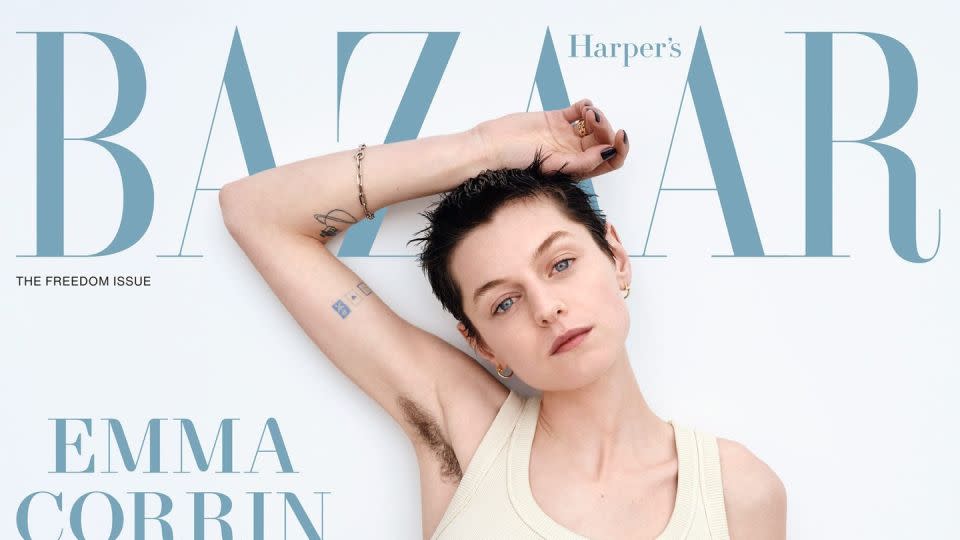Opinion: The uproar over Emma Corrin’s armpits is about more than just a little hair
- Oops!Something went wrong.Please try again later.
Editor’s Note: Patricia Grisafi, PhD, is a freelance writer whose work has been featured in The Guardian, Salon, NBC, Los Angeles Review of Books, The Mary Sue, The Daily Dot and elsewhere. The views expressed here are her own. Read more opinion on CNN.
I stopped shaving my armpits three years ago. Why? I was tired of my sensitive skin being constantly annoyed by irritation and ingrown hairs. But I also wanted an aesthetic change. Something less perfect, less groomed, more wild.

Humans chop and style their hair all the time. They microblade their eyebrows to look fuller and then pluck them into non-existence. Making changes to our body hair is a near-constant element of stylistic transformation that is central to our self-presentation and expressions of individuality. Why then does the perception of armpit hair remain a constant — seen by many as so primally disgusting?
When I talk about armpit hair, I’m talking mostly about women’s armpit hair. Because men are at leisure to do whatever they want with the hair growing on their body, whereas whenever a woman appears in public with tufts of hair peeking out from under her arms, some people feel compelled to weigh in.
For many Americans, critiquing body hair is a way to police gender and judge bodies that inspire fear, judgment or social disruption. So perhaps it’s not a surprise that nonbinary people, who are increasingly more public-facing in the media, might also be scrutinized or criticized for their body hair — its presence, absence or location.
Take the example of nonbinary and queer actor Emma Corrin, who is featured on the June/July cover of Harper’s Bazaar. Corrin, who won a Golden Globe for their portrayal of Princess Diana in “The Crown,” is pictured wearing clothing from Miu Miu — a beige tank top and briefs. Corrin poses with their arm above their head, displaying their armpit hair in a cool but declarative way.

Corrin is no stranger to strong and sometimes toxic reactions. They came out in 2021 and used she/they pronouns initially before asking to be referred to exclusively with they/them pronouns in 2022. “The vitriol is worse than I anticipated…Even though we like to think we’re in a progressive society, a lot of what we’re seeing is increasingly a step back,” Corrin said of homophobic and transphobic reactions to their existence as a person.
Corrin’s recent cover look has brought out more vitriol — this time, with the focus on their armpit hair. The Harper’s Bazaar Instagram account was full of nasty comments that were homophobic, body-shaming and sexist. “Shave please…it’s not about human’s rights…it’s about self hygiene,” said one user who apparently doesn’t understand that body hair has an evolutionary and biological purpose and having armpit hair is in fact hygienic.
“Pits, pronouns. Pass,” said another user, making fun of Corrin’s armpit hair and nonbinary identity. There were also comments about Corrin needing “attention” or trying to be “edgy” with their look, as if it’s weird that someone on the cover of a fashion magazine wants to promote an aesthetic or make a statement about clothing or beauty standards.
Corrin isn’t the first celebrity to be targeted by such commentary in response to visible body hair. When Canadian actress Rachel McAdams was featured in a 2023 photoshoot for Bustle, she also posed in a way that exposed her armpit hair. “This is my body, and I think that’s so important to reflect back out to the world,” McAdams explained. Model and actress Emily Ratajkowski showed her armpit hair for the September 2019 cover of Harper’s Bazaar. She wrote, “For me, body hair is another opportunity for women to exercise their ability to choose — a choice based on how they want to feel and their associations with having or not having body hair.”
It’s especially telling that many of the comments criticizing Corrin were framed as if Corrin were female, their body talked about as if it was a woman’s body. Corrin’s armpit hair was visible, but their gender preference was virtually erased. If women and nonbinary people are perceived in similar ways when it comes to body hair, what does that inform us about our prejudices as a society? It tells me we still have a lot of work to do regarding how we think about nonbinary bodies and gender-nonconforming aesthetic choices.
This isn’t just about the hair under our arms, either. I think of my mother looking at my 6-year-old son and 2-year-old daughter, who both have shoulder-length hair, and her insistence that only he should have a fresh haircut so the hair “doesn’t get in his eyes.” I know what she’s really implying. There’s fear when the reality of hair doesn’t line up with one’s expectations of gender.
Visible armpit hair triggers reactions that reflect manufactured ideals of gender. When looked at this way, this style and grooming choice becomes about more than armpit hair. It becomes symbolic of unruliness and norms being disregarded. It confuses people. It becomes chaos, disorder that many want to see removed, shaved off to maintain the status quo.
We should all feel empowered to express ourselves the way we want — with clothing and with hair. Let your armpits flourish into a bush, wax your legs, keep your pubic hair, shave your big toe, grow a twirly villain’s mustache. If Corrin or anyone else wants to express themselves through hair choices, we should be celebrating the diversity of human expression, not mocking it — and certainly not erasing any aspect of it.
For more CNN news and newsletters create an account at CNN.com

